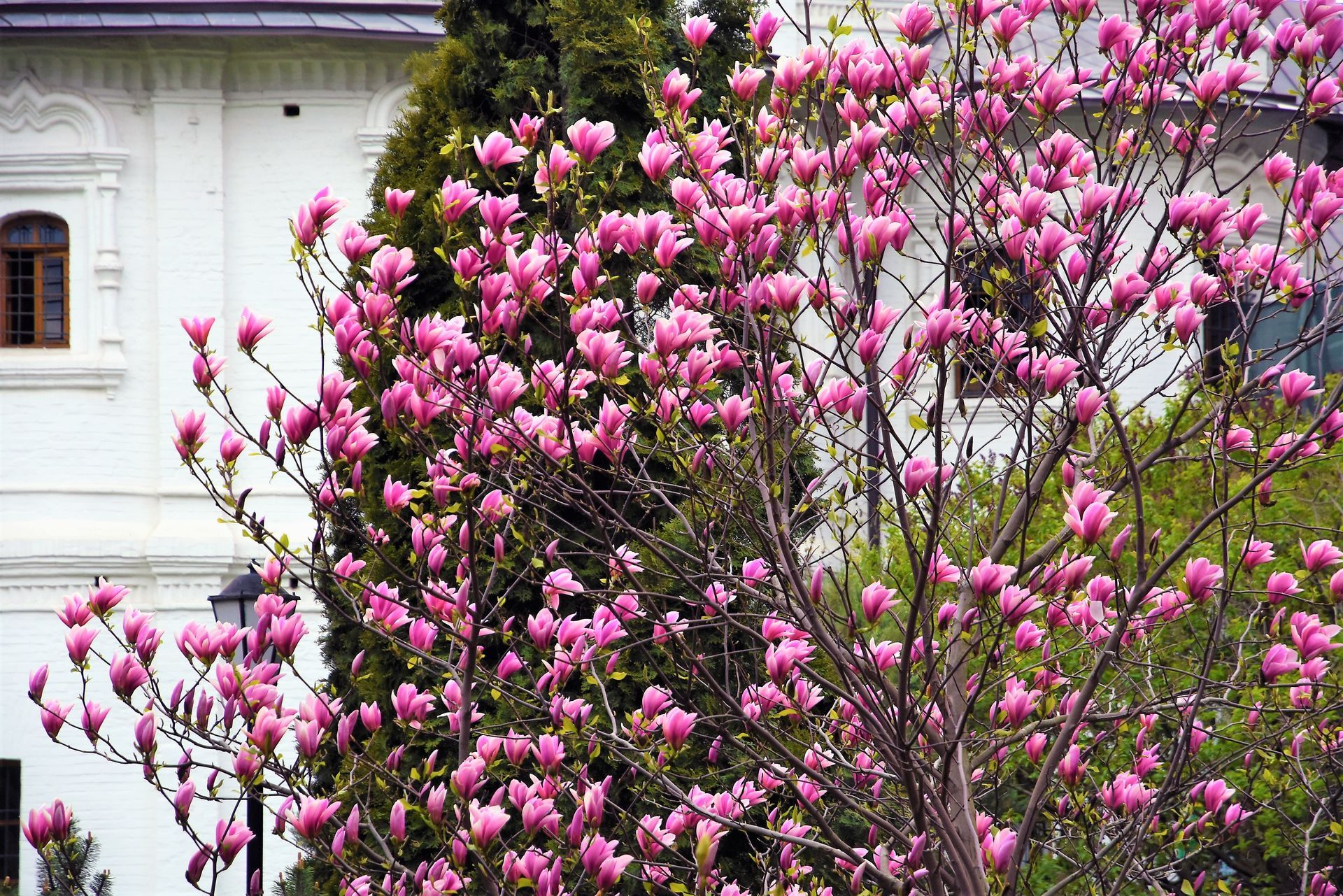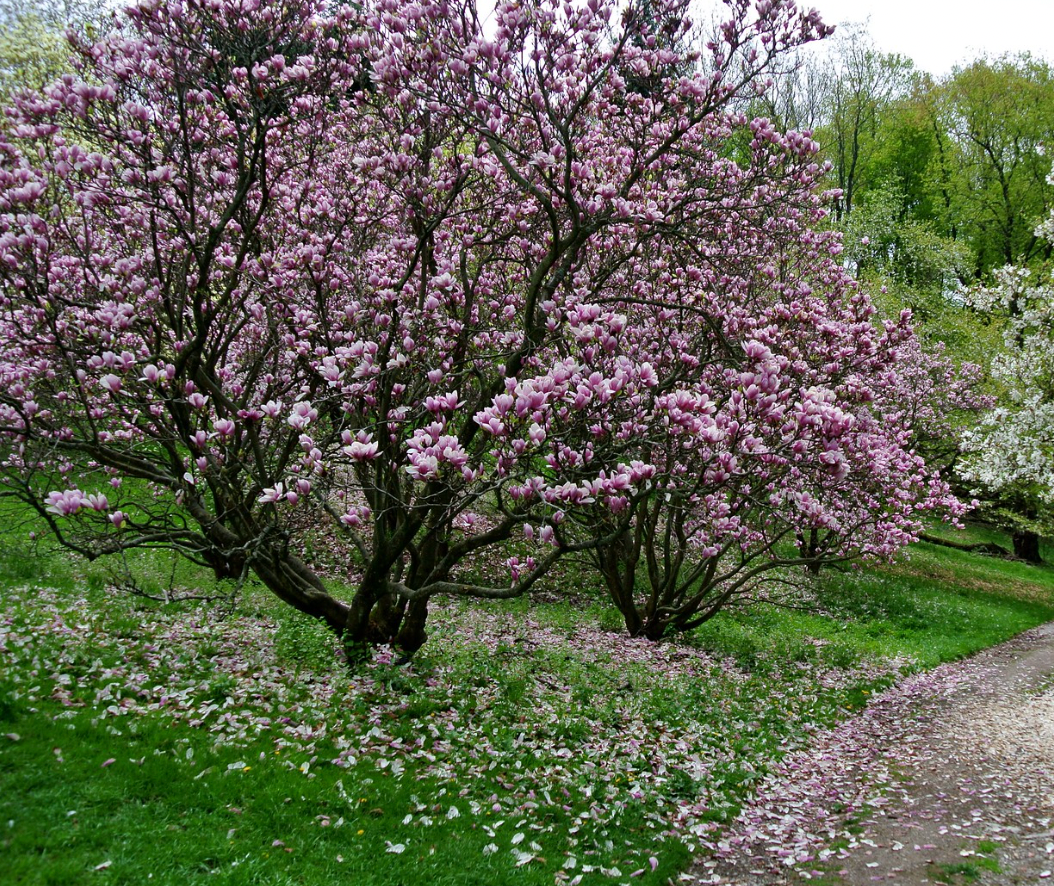Magnolia Tree Care

Magnolia trees are a favorite among homeowners for their fragrant cultivars and showy flowers. The magnolia wood is light and soft, which is why it's often used to make light furniture, boxes, and crates. Growing magnolia trees requires a certain degree of attention to detail, such as proper soil, nutrition, water, and temperature. Here's a guide on magnolia tree care for first-time growers.
Fast Facts for Magnolia Trees
| Common Name | Sweet magnolia, southern magnolia, saucer magnolia |
|---|---|
| Scientific Name | Magnolia stellata, Magnolia soulangeana, and Magnolia grandiflora |
| Month(s) of Harvest | Flowers March through April |
| Light | Full sun and light shade |
| Water | Requires watering once or twice a week for the first few months after planting. Once the roots establish, it only needs water occasionally. |
| Soil | Prefers a well-drained and moist soil rich in organic matter. You might have to add well-rotted manure to provide the proper nutrition to the plant. pH must be between 5.5 and 6.5. |
| Fertilizer | Does best with a 10-10-10 balanced fertilizer |
| Pests | Susceptible to pests like the hoplia beetle, aphids, armored scares, foliage-feeding caterpillars, and greenhouse thrips |
| Diseases | Prone to wood decay, wet wood, powdering mildew, leaf spot diseases, and crown gall |
| Growing Zone | 4 to 8 |
Table of Contents

Credit: Liz West
Magnolia trees are without a doubt, one of the best front yard trees you can have in your landscape. They are favorited by many because of their beautiful blooms and low-maintenance care routine. Check it out below.
How To Take Care of Magnolia Trees
Magnolias grow as trees or large shrubs with fragrant flowers that range in color from white and yellow to pink, red, and purple. Evergreen magnolias have thick, leathery leaves, while deciduous magnolias have thin, soft leaves.
Some examples of evergreen magnolias include:
- Magnolia doltsopa, with scented white flowers
- Magnolia white caviar with tulip-shaped white flowers
- Magnolia figo, with yellow-purple flowers and glossy green leaves
Meanwhile, deciduous magnolias are known for their star-shaped flowers that bloom in late winter. The White Stardust is a beautiful deciduous magnolia which only grows to 4 feet. Other varieties include Magnolia loebneri and Magnolia soulangeana.
Regardless of the type of magnolia trees you choose, it's essential to know the following requirements about this genus.
Soil & Container
The first component of care for magnolia trees is choosing the right soil type and container. Most people prefer to plant magnolia trees outside in their yards. But if you want to grow a smaller cultivar, you can also use a pot.
Make sure the pot is big enough to contain the plant's root ball, which should be twice the size of the pot. Magnolia trees grow best in slightly acidic, well-drained, and moist soils.
The trees can adapt to sandy and loamy soils, but most cultivars do not grow well in poorly-drained or wet soils. Once the plant is well-established, it can moderately tolerate droughts and dry periods.
Root Inspection
Due to their small size in the first few months of growth, growers often plant magnolia trees in pots. But if the plant overgrows its container, you need to transplant it into the ground. Most trees need a space of 4 to 8 meters in diameter.
A smaller pot would have done some damage to the roots. So, you need to look out for that.
When you remove the root ball from the pot, detangle the tangled roots. Also, water the root ball to remove the dirt so that you can look for broken or damaged roots. If you find any, remove them.
You might also see some circling roots. These roots would be growing inward toward the trunk rather than the other way around. Turn their position so that they face outward.
Water Requirements
As already mentioned, magnolia trees grow poorly in overly wet soils. After you plant the tree, water it once or twice a week for the first six months. The roots take about six months to establish, after which the plant will have its own system to gather nutrition from the soil.
After six months, only water the plant in dry spells. When watering, make sure to drench the root system of the plant thoroughly. Don't water too frequently, as it can cause root rot.
Fertilizing and Filling
Use a 10-10-10 multi-purpose fertilizer to provide essential nutrition to your magnolia trees twice or thrice a year. A 10-10-10 ratio means that the fertilizer should have 10% nitrogen, 10% phosphorus, and 10% potassium.
Such a fertilizer is called a 'balanced' fertilizer since it contains equal amounts of all primary macronutrients. The mix would also have micronutrients like iron, manganese, and zinc.
You can also fill the area around the tree with mulch or compost to conserve moisture for extended periods. It prevents the soil from drying out and helps in keeping a consistent water supply available for the plant throughout the year.
Sun & Placement
Magnolia trees can thrive in mildly sunny environments. But if you live in a hot and dry region, you should place your magnolia tree in a space where it gets light shade and moderate sunlight.
The southern magnolia is an exception to this rule since it prefers part shade.
Temperature and Humidity
Magnolia trees require a moderate temperature for survival. They can live in somewhat cold environments, but if the temperature goes below 20 to -10° F, the trees can sustain permanent damage or die.
The same applies to humidity. It should be moderate since low humidity levels can cause the tree to dry out quickly, and high humidity levels can lead to fungal diseases. If the air humidity is below 50% for several days in a row, magnolia leaves can dehydrate and fall off the tree.
Pruning
Pruning is an important step in magnolia tree maintenance since it gives the plant a beautiful shape and allows it to thrive.
- When: The best time to prune magnolias is between mid-summer and early autumn. You should not prune the tree at any other time, especially in early spring or late winter, since pruning cuts become susceptible to bleed sap.
- Tools: Use sharp pruning shears to make clean and precise cuts. They should be sterilized before making the cut to avoid any potential diseases or insect infestations.
Deciduous magnolia trees seldom have to be pruned since they lose their leaves during winter. But you may have to prune them to remove diseased, dead, and damaged limbs or to reduce the tree's size for a well-balanced crown.
Training
If you're growing M. grandiflora, you can also train it to grow against a sunny wall since it flowers well this way. Here's how to do this:
- Attach some kind of support to a warm wall with plenty of sun. The support could be a trellis or horizontal wires arranged in two rows.
- Tie the magnolia's branches to the support at a 45-degree angle. The next season, lower the branches at a horizontal angle.
- When summer arrives, cut the shoots that grow towards the wall.
- Shorten the shoots growing outward to two leaves.
- If the outward-growing shoots have flower buds, do not prune them. Instead, wait to prune them after they flower.
Did You Know? Magnolias are the oldest trees on the White House grounds. Andrew Jackson, the former president, planted these trees in 1829 and 1837 in memory of his late wife.

Credit: RichardBH
Magnolia Tree Problems
Magnolia trees are susceptible to several pests and diseases, including but not limited to powdery mildew, verticillium wilt, scale insects, and magnolia root rot. If you notice any of these symptoms in your magnolia trees, they may be diseased.
Not Flowering
If your magnolia tree is not flowering, you should not get worried immediately. It's likely that the tree is not old enough to produce flowers.
Most magnolia cultivars take about 10 years before they start flowering. Besides, your tree may not flower because it is not in the right hardiness zone or climate. The tree needs enough warmth for it to bloom.
Black Spots
Magnolia leaf disease is any disease that affects the tree's leaves. Many fungi can cause these diseases, including Cercospora and Gloeosporium. These diseases will cause black spots to appear on the tree's leaves.
If a leaf is so heavily covered in black spots that it becomes black or brown, it will die and fall off the tree. The treatment method for magnolia leaf disease is to remove the damaged leaves.
If leaves have fallen on the ground, rake them away. Otherwise, the fungus from these leaves will infect nearby trees and shrubs.
You can also use a copper fungicide to spray the petioles and leaves. Go for another round of spraying after two weeks.
Lesions on Petals
Pseudomonas syringae, the bacteria that causes blight, is the reason for dark lesions on fruits and petals. The bacterium lives on the plant's surface and is spread to other trees through splashing rain.
Periods of low temperature and high moisture favor the development of bacterial blight.
Affected branches do not leaf out when spring arrives. Or, they may produce leaves that fall off quickly as the summer temperatures rise.
Here's how to manage blight:
- Prune the damaged branches and twigs in the dry season.
- Do not do overhead irrigation as it would wet the foliage, making it susceptible to infection.
Currently, there are no bactericides you can use to control this infection.
Holes in Petals
If your magnolia tree's flowers have holes in petals, the hoplia beetle is the culprit. These battles like to chew holes in petals of pink, yellow, and white flowers.
An adult hoplia beetle is about a quarter inch long and oval in shape. Its thorax and head are reddish-brown and dark. Meanwhile, the wing covers are light brown. The larvae are crescent-shaped and burrow in the soil.
Handpicking these beetles from your tree is one way to manage them. After taking them off the tree, put them in a bucket filled with soapy water. Or, you can clip the beetle-infested flowers from the tree and dispose of them.
Alternatively, you can fill a bucket with a mixture of water and detergent. The solution attracts beetles, which will fall inside the bucket and die.
Spraying with an insecticide hasn't been found effective so far since these beetles hide inside the flowers, and the insecticide must come in direct contact to kill them. Similarly, you cannot kill the larvae by spraying them with insecticide since they're inside the soil.
Learning About Magnolia Trees
There are many types of magnolia trees, ranging from small shrubs to large flowering trees. Here are some notable magnolia species.
Ashe's Magnolia (Magnolia ashei)
Ashe's magnolia tree can grow to be a small tree or a large shrub based on how you prune it. Its white flowers have foot-long petals that bloom after the appearance of light-green leaves in spring.
Ahe's magnolia has a height of up to 30 feet. They grow in the USDA hardiness zones 6 to 9 and are native to Florida.
Anise Magnolia (Magnolia salicifolia)
Anise magnolia's leaves look similar to that of a willow tree. It's a deciduous tree with white flowers that bloom in early spring. In fall, the tree changes color to a golden yellow.
Anise magnolia is native to Japan and grows up to 30 feet.
Saucer Magnolia (Magnolia x soulangiana)
The saucer magnolia is one of the most popular magnolia species produced by a cross between the Yulan magnolia and the lily magnolia. It has white blowers with pink insides that appear in early spring.
Saucer magnolia trees grow in US hardiness zones 4 to 9 and grow up to 25 feet.
Southern Magnolia (Magnolia grandiflora)
Unlike most magnolia trees, southern Magnolias thrive best in part shade. It can grow 60 to 80 feet tall and has large elliptical leaves.
The southern magnolia is the state flower of Mississippi and Louisiana.
Sweetbay Magnolia (Magnolia virginiana)
Sweet bay magnolia is also called laurel magnolia, swamp magnolia, and beaver tree. When grown in colder regions, it becomes a deciduous shrub, but it maintains an upright habit and stays evergreen when it grows in warmer areas. The tree can get to a height of 10 to 35 feet in the right conditions.
Star Magnolia (Magnolia stellata)
Start magnolia is a deciduous magnolia tree with star-shaped flowers that grow in early spring or late winter. The tree is native to Japan and attains a height of 15 to 20 feet.
Magnolia Tree Origin Story
Magnolia trees are among the most primitive plants in the world. According to fossil records, magnolias used to exist in Asia, North America, and Europe about 100 million years ago.
Now, they are native to the southern United States and southern China today. Archaeological data show that the oldest magnolia fossils were nearly a hundred million years old. That makes magnolias among the oldest flowering plants.
The tree was discovered by a French botanist called Pierre Magnol, who discovered magnolias in Louisiana and took its seedlings to France with him.
Sweet New Earth's Final Word On Magnolia Trees
Magnolia tree care involves proper soil selection, infrequent watering, annual fertilization, and pruning. Magnolia trees can range in size from 15-foot shrubs to trees reaching heights of up to 80 feet.
Magnolia trees grow around 12" to 24" annually, making them slow growers. The deciduous varieties produce flowers in spring. Meanwhile, evergreen trees bloom from spring to summer.
However, you might see re-blooms in early fall or summer since it's common for magnolias to produce sporadic blooms.
An important part of magnolia tree health is to follow proper cultural practices, such as proper pruning. Do not let water pool around the tree since it will make magnolias susceptible to fungal attacks and other diseases.

Christina Hernandez
Christina has done most of her research on environmental science but recently has changed her focus towards sustainable forestry. She has a passion for the outdoors and wants to spread that passion to the world.
Join our community!
Join to receive guides, insights, and the latest gardening deals!
